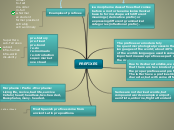PREFIXES
is a morpheme class affixes that comes before a root or lexeme lexical lexical base to form a shape with different meanings (derivative prefix) or expressing different grammatical categories (inflectional prefix).
The prefixes are moderately frequent morphological process in the languages of the world; about 40% of the world's languages used in some important measure prefixes as part of the morfología.2
Due to its characteristics, we can say that there are two kinds of prefixes: the proper prefixes and prefijoides. The latter have a prefixes like character, but with some differences:
They have a lexical meaning, because they are actually coming from Latin substantive lexemes
Series are not derived words, but compound words examples: airport, aeroflota, airborne, flight attendant
They can appear at the beginning or end of words, examples filosoviético / bibliophile, graphomania / photocopying, engulf, aerófago.
Examples of prefixes
to-last
to-text
dis-order
in-full
a-Normal
ex student
former president
extra big
extra-ordinary
pre-history
pre-fixed
pre-bond
re-do
re-mormado
re-introduction
super-market
over-load
Super Hero
sub-Terraneo
subsoil
infra-human
infra-world
dis-ability
dis-lying
dis-locado
bi-mo-
bi-sexual
bi-polar
Morpheme: Prefix + Morpheme:
Living life, revive, bad life, survive
Céfalo (head) headless, two-headed, Bucephalus, many-headed.
Most Spanish prefixes come from ancient Latin prepositions.
However the class of prefijoides are Latin or Greek roots, used to form new words.
